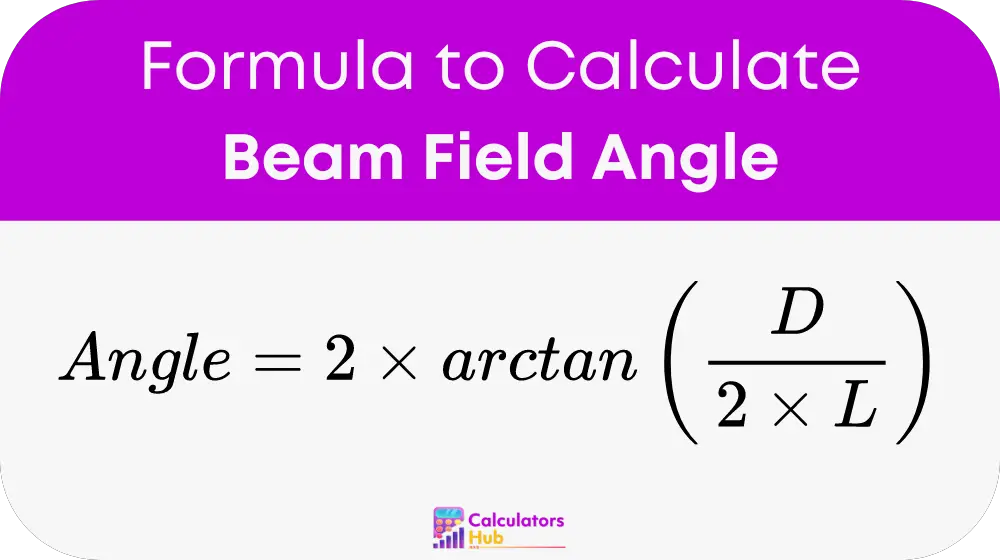The Beam Field Angle Calculator calculates the angle at which light spreads out from a source to cover a specific area at a given distance. This angle, known as the beam field angle, is critical in determining how well a light source will illuminate a target area. By inputting the diameter of the beam's footprint and the distance from the light source, the calculator provides the beam field angle, helping designers choose the right lighting equipment and setup for their needs.
Formula of Beam Field Angle Calculator
The Beam Field Angle Calculator uses the following formula to calculate the beam field angle:
Beam Field Angle Formula:

Explanation:
- D: The diameter of the beam's footprint at the distance L from the light source. This represents the width of the area illuminated by the beam.
- L: The distance from the light source to the point where the beam's diameter is measured. This is the distance between the light and the target area.
- arctan: The inverse tangent function, which calculates the angle from the ratio of the beam's radius to the distance.
How It Works:
- D (Diameter of Beam’s Footprint): This value is the width of the light beam at a specific distance from the source. It defines how large the illuminated area is at that distance.
- L (Distance from Light Source): This value represents how far the target area is from the light source.
- arctan Function: The inverse tangent function converts the ratio of the beam's radius to the distance into an angle, providing the beam field angle.
By calculating this angle, the Beam Field Angle Calculator helps designers and engineers predict how light will spread in a given space, allowing them to optimize the lighting setup.
Table for General Terms
To aid in understanding the concepts related to beam field angle calculations, here’s a table of key terms:
| Term | Definition |
|---|---|
| Beam Field Angle | The angle at which light from a source spreads out to cover a specific area. |
| Diameter of Beam’s Footprint | The width of the area illuminated by the beam at a given distance. |
| Distance from Light Source | The distance between the light source and the target area. |
| arctan (Inverse Tangent) | A mathematical function used to calculate angles from ratios. |
| Illumination | The amount of light that reaches a surface, often influenced by the beam field angle. |
Example of Beam Field Angle Calculator
Let’s explore an example to illustrate how the Beam Field Angle Calculator works:
Scenario
You are setting up stage lighting for a theater production and need to ensure that a spotlight illuminates a 4-meter-wide area on the stage from a distance of 10 meters.
Inputs:
- Diameter of Beam’s Footprint (D): 4 meters
- Distance from Light Source (L): 10 meters
Calculation:
Using the formula:
- Beam Field Angle (in degrees) = 2 * arctan(4 / (2 * 10))
- Beam Field Angle (in degrees) = 2 * arctan(4 / 20)
- Beam Field Angle (in degrees) = 2 * arctan(0.2) ≈ 22.92 degrees
Interpretation:
The Beam Field Angle Calculator estimates that the beam field angle is approximately 22.92 degrees. This angle ensures that the spotlight will cover the desired 4-meter-wide area on the stage when positioned 10 meters away. By adjusting the beam field angle, you can fine-tune the lighting to achieve the desired effect, ensuring that the stage is well-illuminated for the performance.
Most Common FAQs
The beam field angle is crucial because it determines how light spreads from a source, affecting the coverage and intensity of illumination. A well-calculated beam field angle ensures that the target area is evenly lit, enhancing visibility and aesthetic appeal.
Yes, the Beam Field Angle Calculator can be used for various types of lighting, including stage lighting, architectural lighting, photography lighting, and more. It is versatile and applicable to any scenario where precise light distribution is required.
The beam field angle is influence by the diameter of the beam’s footprint, the distance from the light source, and the design of the light fixture. Different fixtures and lenses can alter the beam's spread, making it important to calculate the angle for each specific setup.